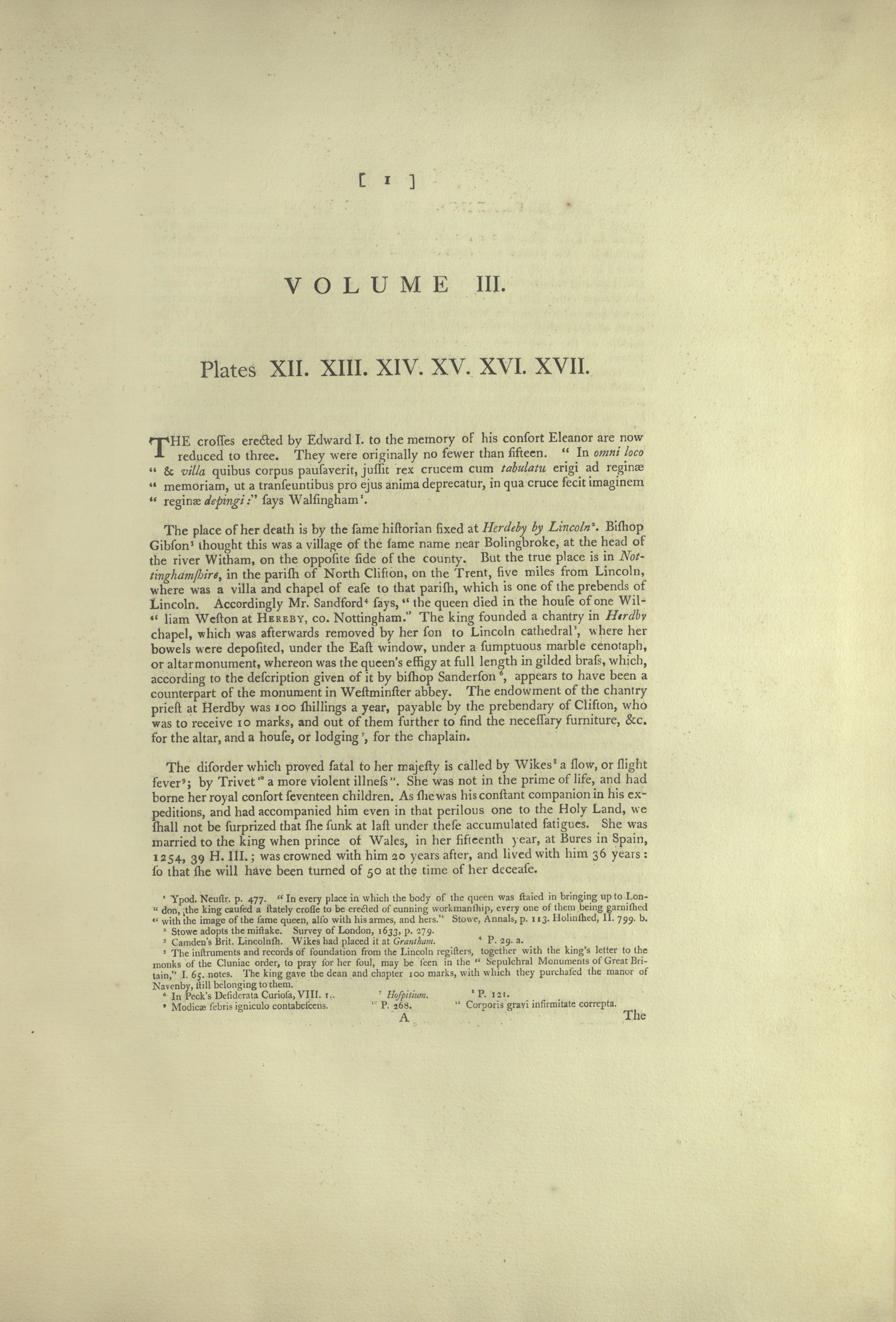
[ (Page) 1 ]
VOLUME III.
Plates XII. XIII. XIV. XV. XVI. XVII.
The crosses erected by Edward I. to the memory of his consort Eleanor are now reduced to three. They were originally no fewer than fifteen. “In omni loco & villa quibus corpus pausaverit, jussit rex crucem cum tabulatu erigi ad reginae memoriam, ut a transeuntibus pro ejus anima deprecatur, in qua cruce fecit imaginem reginae depingi:” [see end of document for translation] says Walsingham1.
Read more/less…The place of her death is by the same historian fixed at Herdeby by Lincoln2. Bishop Gibson3 thought this was a village of the same name near Bolingbroke, at the head of the river Witham, on the opposite side of the county. But the true place is in Nottinghamshire, in the parish of North Clifton, on the Trent, five miles from Lincoln, where was a villa and chapel of ease to that parish, which is one of the prebends of Lincoln. Accordingly Mr. Sandford4 says, “the queen died in the house of one William Weston at HEREBY, co. Nottingham.” The king founded a chantry in Herdby chapel, which was afterwards removed by her son to Lincoln cathedral5, where her bowels were deposited, under the East window, under a sumptuous marble cenotaph, or altar monument, whereon was the queen’s effigy at full length in gilded brass, which, according to the description given of it by bishop Sanderson6, appears to have been a counterpart of the monument in Westminster abbey. The endowment of the chantry priest at Herdby was 100 shillings a year, payable by the prebendary of Clifton, who was to receive 10 marks, and out of them further to find the necessary furniture, &c. for the altar, and a house, or lodging7, for the chaplain.
The disorder which proved fatal to her majesty is called by Wikes8 a slow, or slight fever9; by Trivet10 a more violent illness11. She was not in the prime of life, and had borne her royal consort seventeen children. As she was his constant companion in his expeditions, and had accompanied him even in that perilous one to the Holy Land, we shall not be surprized that she sunk at last under these accumulated fatigues. She was married to the king when prince of Wales, in her fifteenth year, at Bures in Spain, 1254, 39 H. III.; was crowned with him 20 years after, and lived with him 36 years: so that she will have been turned of 50 at the time of her decease.
1Ypod. Neustr. p. 477. “In every place in which the body of the queen was staied in bringing up to London, the king caused a stately crosse to be erected of cunning workmanship, every one of them being garnished with the image of the same queen, also with his armes, and hers.” Stowe, Annals, p. 113. Holinshed, II. 799. b.
2Stowe adopts the mistake. Survey of London, 1633, p. 279.
3Camden’s Brit. Lincolnsh. Wikes had placed it at Grantham.
4P. 29. a.
5The instruments and records of foundation from the Lincoln registers, together with the king’s letter to the monks of the Cluniac order, to pray for her soul, may be seen in the “ Sepulchral Monuments of Great Britain,” I. 65. notes. The king gave the dean and chapter 100 marks, with which they purchased the manor of Navenby, still belonging to them.
6In Peck’s Desiderata Curiosa, VIII. I..
7Hospitium.
8P. 121.
9Modicae febris igniculo contabescens. [Weakened by the touch (lit. “little fire”) of a slight fever.]
10P. 268.
11Corporis gravi infirmitate correpta. [Seized by a serious infirmity (sickness) of the body.]
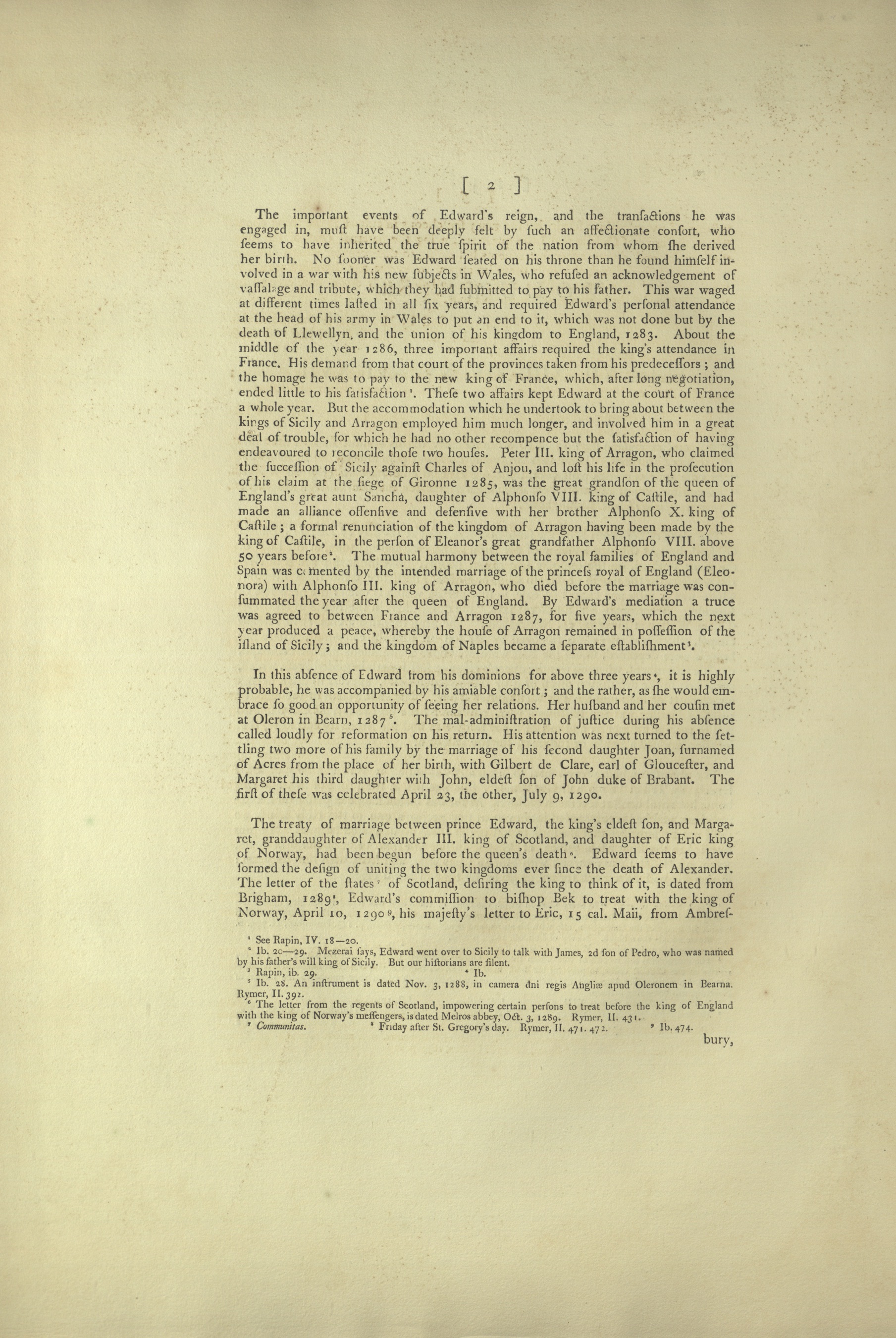
[ (Page) 2 ]
The important events of Edward’s reign, and the transactions he was engaged in, must have been deeply felt by such an affectionate consort, who seems to have inherited the true spirit of the nation from whom she derived her birth. No sooner was Edward seated on his throne than he found himself involved in a war with his new subjects in Wales, who refused an acknowledgement of vassalage and tribute, which they had submitted to pay his father. This war waged at different times lasted in all six years, and required Edward’s personal attendance at the head of his army in Wales to put an end to it, which was not done but by the death of Llewellyn, and the union of his kingdom to England, 1283.
Read more/less…About the middle of the year 1286, three important affairs required the king’s attendance in France. His demand from that court of the provinces taken from his predecessors; and the homage he was to pay to the new king of France, which, after long negotiation, ended little to his satisfaction1. These two affairs kept Edward at the court of France a whole year. But the accommodation which he undertook to bring about between the kings of Sicily and Arragon employed him much longer, and involved him in a great deal of trouble, for which he had no other recompence but the satisfaction of having endeavoured to reconcile those two houses. Peter III. king of Arragon, who claimed the succession of Sicily against Charles of Anjou, and lost his life in the prosecution of his claim at the siege of Gironne 1285, was the great grandson of the queen of England’s great aunt Sancha, daughter of Alphonso VIII. king of Castile, and had made an alliance offensive and defensive with her brother Alphonso X. king of Castile; a formal renunciation of the kingdom of Arragon having been made by the king of Castile, in the person of Eleanor’ s great grandfather Alphonso VIII. above 50 years before2. The mutual harmony between the royal families of England and Spain was cemented by the intended marriage of the princess royal of England (Eleonora) with Alphonso III. king of Arragon, who died before the marriage was consummated the year after the queen of England. By Edward’s mediation a truce was agreed to between France and Arragon 1287, for five years, which the next year produced a peace, whereby the house of Arragon remained in possession of the island of Sicily; and the kingdom of Naples became a separate establisment3.
In this absence of Edward from his dominions for above three years4, it is highly probable, he was accompanied by his amiable consort; and the rather, as she would embrace so good an opportunity of seeing her relations. Her husband and her cousin met at Oleron in Bearn, 12875. The mal-administration of justice during his absence called loudly for reformation on his return. His attention was next turned to the settling two more of his family by the marriage of his second daughter Joan, surnamed of Acres from the place of her birth, with Gilbert de Clare, earl of Gloucester, and Margaret his third daughter with John, eldest son of John duke of Brabant. The first of these was celebrated April 23, the other, July 9, 1290.
The treaty of marriage between prince Edward, the king’s eldest son, and Margaret, granddaughter of Alexander III. king of Scotland, and daughter of Eric king of Norway, had been begun before the queen’s death6. Edward seems to have formed the design of uniting the two kingdoms ever since the death of Alexander. The letter of the states7 of Scotland, desiring the king to think of it, is dated from Brigham, 12898, Edward’s commission to bishop Bek to treat with the king of Norway, April 10, 12909, his majesty’s letter to Eric, 15 cal. Maii, from Ambres-[bury]
1See Rapin, IV. 18—20.
2Ib. 20—29. Mezerai says, Edward went over to Sicily to talk with James, 2d son of Pedro, who was named by his father’s will king of Sicily. But our historians are silent.
3Rapin, ib. 29.
4Ib.
5Ib. 28. An instrument is dated Nov. 3, 1288, in camera dni regis Angliæ apud Oleronem in Bearna [in the chamber of the lord king of England at Oleron in Bearn]. Rymer, II. 392.
6The letter from the regents of Scotland, impowering certain persons to treat before the king of England with the king of Norway’s messengers, is dated Meiros abbey, Oct. 3, 1289. Rymer, II. 431.
7Communitas.
8 Friday after St. Gregory’s day. Rymer, II. 471. 472.
9Ib. 474.
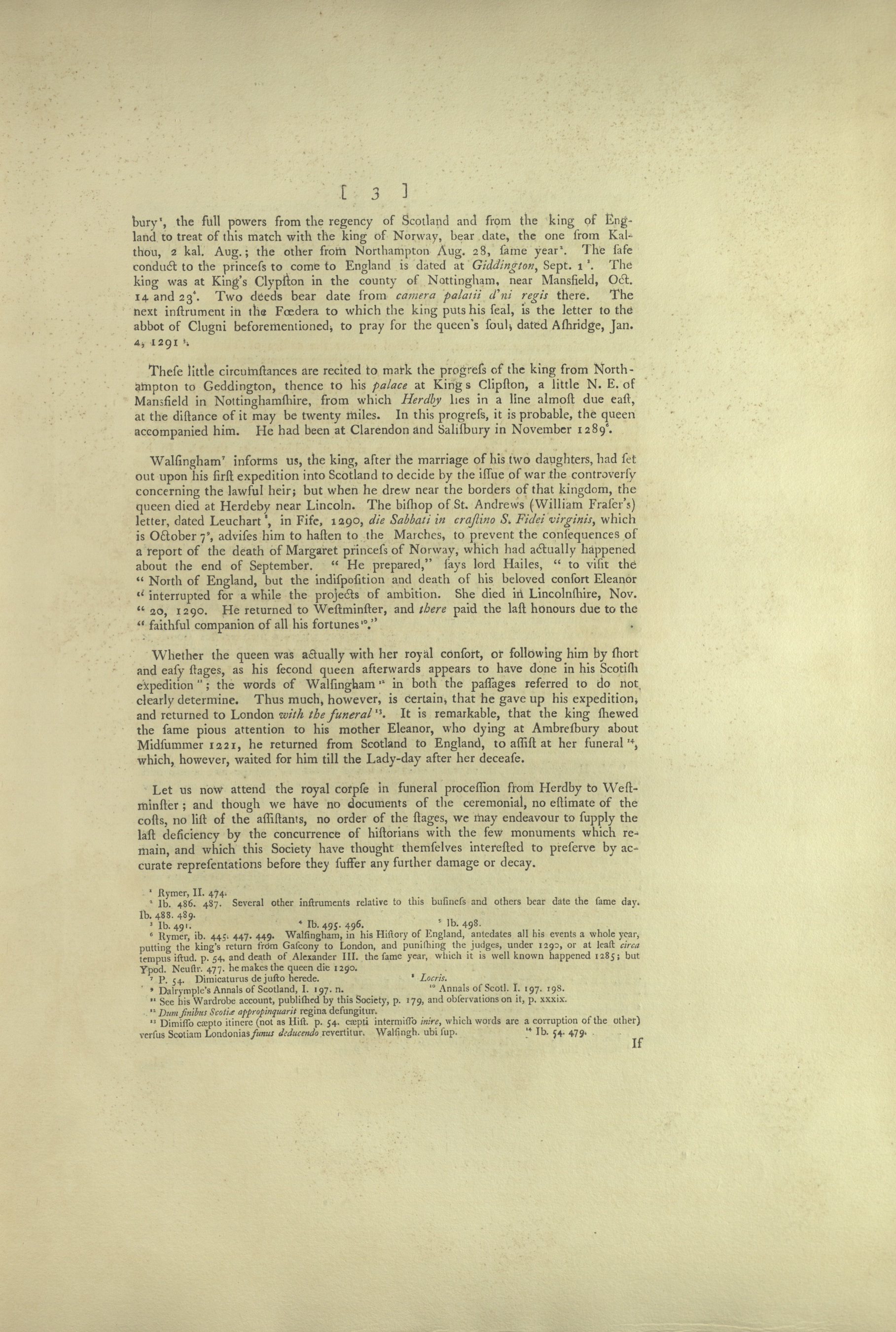
[ (Page) 3 ]
[Ambres-]bury1, the full powers from the regency of Scotland and from the king of England to treat of this match with the king of Norway, bear date, the one from Kalthou, 2 kal. Aug.; the other from Northampton Aug. 28, same year2. The safe conduct to the princess to come to England is dated at Giddington, Sept. 13. The king was at King’s Clypston in the county of Nottingham, near Mansfield, Oct. 14 and 234. Two deeds bear date from camera palatii d’ni regis [The chamber of the lord king’s palace] there. The next instrument in the Fœdera to which the king puts his seal, is the letter to the abbot of Clugni beforementioned, to pray for the queen’s soul, dated Ashridge, Jan 4, 12915.
Read more/less…
These little circumstances are recited to mark the progress of the king from Northampton to Geddington, thence to his palace at King’s Clipson, a little N. E. of Mansfield in Nottinghamshire, from which Herdby lies in a line almost due east, at the distance of it may be twenty miles. In this progress, it is probable, the queen accompanied him. He had been at Clarendon and Salisbury in November 12896.
Walsingham7 informs us, the king, after the marriage of his two daughters, had set out upon his first expedition into Scotland to decide by the issue of war the controversy concerning the lawful heir; but when he drew near the borders of that kingdom, the queen died at Herdeby near Lincoln. The bishop of St. Andrews (William Fraser’s) letter, dated Leuchart8, in Fife, 1290, die Sabbati in crastino S. Fidei virginis [on the day of the Sabbath, on the morrow of Saint Faith the Virgin], which is October 79, advises him to hasten to the Marches, to prevent the consequences of a report of the death of Margaret princess of Norway, which had actually happened about the end of September. “He prepared,” says lord Hailes, “to visit the North of England, but the indisposition and death of his beloved consort Eleanor interrupted for a while the projects of ambition. She died in Lincolnshire, Nov. 20, 1290. He returned to Westminster, and there paid the last honours due to the faithful companion of all his fortunes10.”
Whether the queen was actually with her royal consort, or following him by short and easy stages, as his second queen afterwards appears to have done in his Scottish expedition11; the words of Walsingham12 in both the passages referred to do not clearly determine. Thus much, however, is certain, that he gave up his expedition, and returned to London with the funeral13. It is remarkable, that the king shewed the same pious attention to his mother Eleanor, who dying at Ambresbury about Midsummer 1221, he returned from Scotland to England, to assist at her funeral14, which, however, waited for him till the Lady-day after her decease.
Let us now attend the royal corpse in funeral procession from Herdby to Westminster; and though we have no documents of the ceremonial, no estimate of the costs, no list of the assistants, no order of the stages, we may endeavour to supply the last deficiency by the concurrence of historians with the few monuments which remain, and which this Society have thought themselves interested to preserve by accurate representations before they suffer any further damage or decay.
1Rymer, II. 474.
2Ib. 486. 487. Several other instruments relative to this business and others bear date the same day. Ib. 488. 489.
3Ib. 491.
4Ib. 495. 496.
5Ib. 498.
6Rymer, ib. 445. 447. 449. Walsingham, in his History of England, antedates all his events a whole year, putting the king’s return from Gascony to London, and punishing the judges, under 1290, or at least circa tempus istud. [around that time] p. 54, and death of Alexander III. the same year, which it is well known happened 1285; but Ypod. Neustr. 477. he makes the queen die 1290.
7P. 54. Dimicaturus de justo herede. [To fight over the rightful heir.]
8Locris.
9Dalrymple’s Annals of Scotland, I. 197. n.
10Annals of Scotl. I. 197.198.
11See his Wardrobe account, published by this Society, p. 179, and observations on it, p. xxxix.
12Dum finibus Scotiæ appropinquarit regina defungitur [When the queen arrived at Scotland, she died (lit. “dies”).]
13Dimisso cæpto itinere (not as Hist. p. 54. Caepti intermisso inire, which words are a corruption of the other) versus Scotiam Londonias funus deducendo revertitur. Walsingh. ubi sup. [After the expedition undertaken to Scotland was given up, he returned (lit. “returns”) to London escorting the funeral.]
14Ib. 54. 479.

[ (Page) 4 ]
If we believe Walsingham, we should expect to find them in every place (“locus”) and town (“villa”) where the body rested. But the fact is, we have accounts of them only in considerable towns, to the amount of fifteen, including Herdby and Charing.
Read more/less…
These were:
HERDBY.
LINCOLN.
NEWARK.
LEICESTER.
NORTHAMPTON.
STONY STRATFORD.
DUNSTAPLE.
ST. ALBAN’S.
WALTHAM.
CHEAPSIDE.
CHARING BY WESTMINSTER.
GRANTHAM.
STAMFORD.
GEDDINGTON.
WOBURN[.]
What reason there is for fixing one at Herdby does not appear, except that it was the primary station from whence all the rest were to be ranged.
Dr. Stukeley1 says, “in Leland’s time one of the stone crosses of queen Eleanor “was here, [at LINCOLN,] standing in the market place.” All that Leland2 says is, “[a little] without . . . . . .barre is a very fair [crosse], and large.” If this is to be understood of an Eleanor cross, it is the situation wherein such crosses stood at Grantham Northampton, Waltham, &c. Mr. Camden3 puts one at Lincoln.
Dr. Stukeley, in a MS note on his Itinerary, I. p. 34, inclines to transfer the crosses from NEWARK and LEICESTER to Grantham and Stamford. He says nothing of it at Newark, p.99, nor at Leicester, p. 103.
GRANTHAM and STAMFORD were two stages.
“Mr. Howgrave says, there was a queen’s cross at Stamford, and the like is affirmed of Grantham, and that it stood in the open place in the London road; and I saw a stone carved with foliage work, said to be part of it; and I believe it, seeming of that sort of work. If so, then Newark and Leicester must be left out; and they travelled with the queen’s corpse by way of Oundle to Giddington from Stamford; the present road from Stamford being, I suppose, impassable, or not having at that time royal seats, manors, or abbies, by the way, sufficient to entertain the cavalcade. Mr. Peck, in his Antiquities of Stamford, asserts, Grantham and Stamford to be two of the stages where crosses were erected. No doubt that at Grantham stood in the open London road, opposite my neighbour Hacket’s house, called Peterchurch hill, and the people have some memory of it. Mr. Peck puts in Woburne between Dunstable and St. Alban’s, on what authority I know not4.”
But the existence of such a cross at Stamford is put out of all doubt by Mr. Butcher, who, in his account of the town printed 16465, says, “Not far from High Dike, on the North side of the town of Stamford, near unto York highway, and about twelve score from the town gate, called Clement gate, stands an ancient crosse of free-[stone]
1Itin. Cur. I. 87.
2Itin. I. 33.
3Remains, art. Wise Speeches, p. 260.
4Stukeley, Itin. Cur. I. 34, 35, 2d ed.
5P. 27.
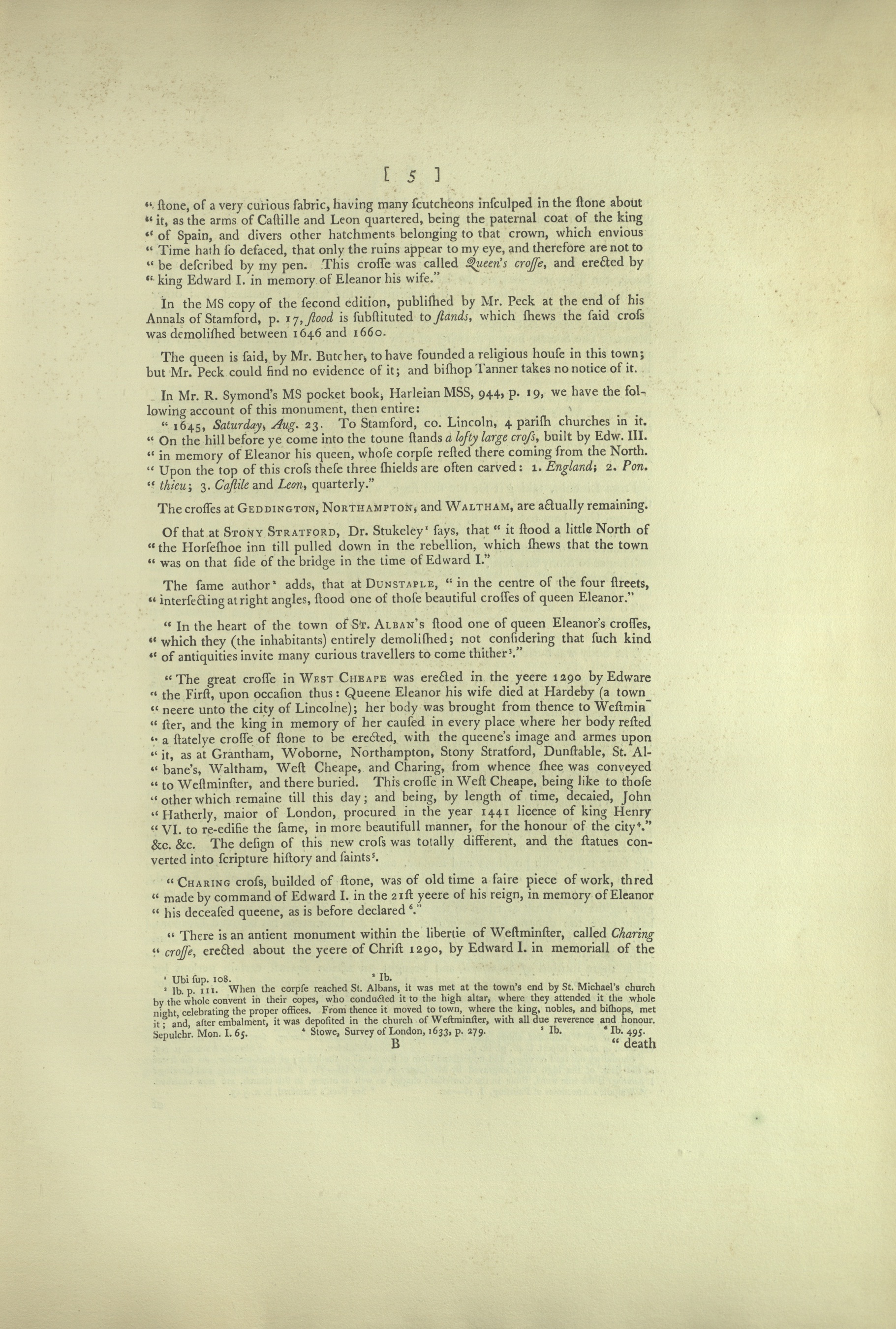
[ (Page) 5 ]
[free-]stone, of a very curious fabric, having many scutcheons insculped in the stone about it, as the arms of Castille and Leon quartered, being the paternal coat of the king of Spain, and divers other hatchments belonging to that crown, which envious Time hath so defaced, that only the ruins appear to my eye, and therefore are not to be described by my pen. This crosse was called Queen’s crosse, and erected by king Edward I. in memory of Eleanor his wife.”
Read more/less…
In the MS copy of the second edition, published by Mr. Peck at the end of his Annals of Stamford, p. 17, stood is substituted to stands, which shews the said cross was demolished between 1646 and 1660.
The queen is said, by Mr. Butcher, to have founded a religious house in this town; but Mr. Peck could find no evidence of it; and bishop Tanner takes no notice of it.
In Mr. R. Symond’s MS pocket book, Harleian MSS, 944, p. 19, we have the following account of this monument, then entire:
“1645, Saturday, Aug. 23. To Stamford, co. Lincoln, 4 parish churches in it. On the hill before ye come into the toune stands a lofty large cross, built by Edw. III. in memory of Eleanor his queen, whose corpse rested there coming from the North. Upon the top of this cross these three shields are often carved: 1. England; 2. Pon. Thieu; 3. Castile and Leon, quarterly.”
The crosses at GEDDINGTON, NORTHAMPTON, and WALTHAM, are actually remaining.
Of that at STONY STRATFORD, Dr. Stukeley1 says, that “it stood a little North of the Horseshoe inn till pulled down in the rebellion, which shews that the town was on that side of the bridge in the time of Edward I.”
The same author2 adds, that at DUNSTAPLE, “in the centre of the four streets, intersecting at right angles, stood one of those beautiful crosses of queen Eleanor.”
“In the heart of the town of ST. ALBAN’S stood one of queen Eleanor’s crosses, which they (the inhabitants) entirely demolished; not considering that such kind of antiquities invite many curious travelers to come thither3.”
“The great crosse in WEST CHEAPE was erected in the yeere 1290 by Edware the First, upon occasion thus: Queene Eleanor his wife died at Hardeby (a town neere unto the city of Lincolne); her body was brought from thence to Westminster, and the king in memory of her caused in every place where her body rested a statelye crosse of stone to be erected, with the queene’s image and armes upon it, as at Grantham, Woborne, Northampton, Stony Stratford, Dunstable, St. Albane’s, Waltham, West Cheape, and Charing, from whence shee was conveyed to Westminster, and there buried. This crosse in West Cheape, being like to those other which remaine till this day; and being, by length of time, decaied, John Hatherly, maior of London, procured in the year 1441 licence of king Henry VI. to re-edifie the same, in more beautifull manner, for the honour of the city4.” &c. &c. The design of this new cross was totally different, and the statues converted into scripture history and saints5.
“CHARING cross, builded of stone, was of old time a faire piece of work, thred made by command of Edward I. in the 21st yeere of his reign, in memory of Eleanor his deceased queene, as is before declared6.”
“There is an antient monument within the libertie of Westminster, called Charing crosse, erected about the yeere of Christ 1290, by Edward I. in memorial of the
1Ubi sup. 108.
2Ib.
3Ib. p. 111. When the corpse reached St. Albans, it was met at the town’s end by St. Michael’s church by the whole convent in their copes, who conducted it to the high altar, where they attended it the whole night, celebrating the proper offices. From thence it moved to town, where the king, nobles, and bishops, met it; and, after embalment, it was deposited in the church of Westminster, with all due reverence and honour. Sepulchr. Mon. I. 65.
4Stowe, Survey of London, 1633, p. 279.
5Ib.
6Ib. 495.

[ (Page) 6 ]
“death of Elineor his queene, who died at Hardlie [read Hardbie] near Lincolne, and was buried in Westminster1.”
This cross stood in the centre of the three streets, having on the West St. James’s hospital, now occupied by St. James’s palace and park; and on the South on the right hand, the Tilt-yard, and, on the left hand, a space, now called Scotland-yard, formerly occupied by buildings for the receipt of the kings of Scotland, and other estates of that country2.
Read more/less…What authority there is for the supposing Charing the name of a village, does not appear3. Mr. Camden4 only places this cross near the Mews. The Society have a drawing of it by Mr. Vertue, representing it in a far less perfect state than the others, but when it was taken does not appear. It was succeeded by the statue of king Charles I.
Mr. Camden (who undoubtedly had seen all these crosses) enumerates ten in his Remains (art. Wise Speeches, p. 261. 347), Lincoln, Grantham, Stamford, Geddington, Northampton, Stony Stratford, Dunstable, St. Alban’s, Waltham, and Westminster, called Charing cross; and this will justify Sir H. Englefield in not admitting Herdby, Newark, Leicester, Cheap, and Woburne.
From Lincoln, taking it for the first stage, where the bowels would be buried at the time the body rested, to Grantham, are 20 miles.
From Grantham to Stamford, 20
From Stamford to Oundle, 15; and so to Geddington.
Thence to Northampton, 29
Thence to Stony Stratford, 13
To Dunstable, 15
To St. Albans, 12
To Waltham, across the country, not less than 20
To Westminster, 16
The body was buried December 175.
The greatest difficulty is to account how the procession came to Waltham, unless it struck across by the North edge of Enfield chace, from Barnet; perhaps out of compliment to that mitred abbey of antient and royal foundation, or for better accommodation. That the body rested there the cross itself bespeaks; and by this road only could it be conveyed through Cheapside, and probably rest in St. Paul’s cathedral.
Mr. Vertue, with great probability, supposed these crosses were built on the designs of Peter Cavalini, a Roman sculptor, whom, from various circumstances, he discovered to have been the architect of the shrine of Edward the Confessor in Westminster abbey. Whether this artist was invited hither by abbot Ware about 1260, or followed king Edward after his visit to pope Gregory X. at Rome; to him we may also ascribe the tomb of Edward’s father Henry III. in the same church, beautified in the same taste, with porphyry and mosaic, and the first brazen statue known to be cast in England lying on it. The old paintings6 round the chapel of St. Edward, and those in a very beautiful and superior style, though much decayed, over the ragged regiment, Vertue ascribed to the same Cavalini. This painter and sculptor probably gave the designs for the crosses erected by Edward to his beloved Eleanor7. Mr. Walpole pursues the conjecture further, and suspects that a son of Peter Cavalini is the person called Peter le Orfever, mentioned in a precept of Edward the Second. He is there intitled of Stamford, and brought an action against certain persons for assault and battery. As one of queen Eleanor’s crosses was erected there, it is not improbable that a son of Cavalini might marry and settle in that town8. The head
1Norden’s Middlesex.
2Stowe. Ib. 495.
3A view of Westminster abbey and St. James’s, from the village of Charing, supposed by Hollar, was engraved in Antiq. Repert. I. 40. pl. ix. p.
4Brit. Middlesex.
5Stowe’s Annals, p. 113.
6Should we not read carvings, and understand them of the reliefs of the history of the Confessor, on the frieze at the back of the high altar; engraved by Mr. Carter in his No III—VI. of Antient Painting and Carving? If paintings is the true word, those in the Confessor’s chapel, as well as others, in this church, are now vanished.
7Walpole’s Anecdotes of Painting, I. 18—20.
8See Peck’s Stamford, b. x. § 13.
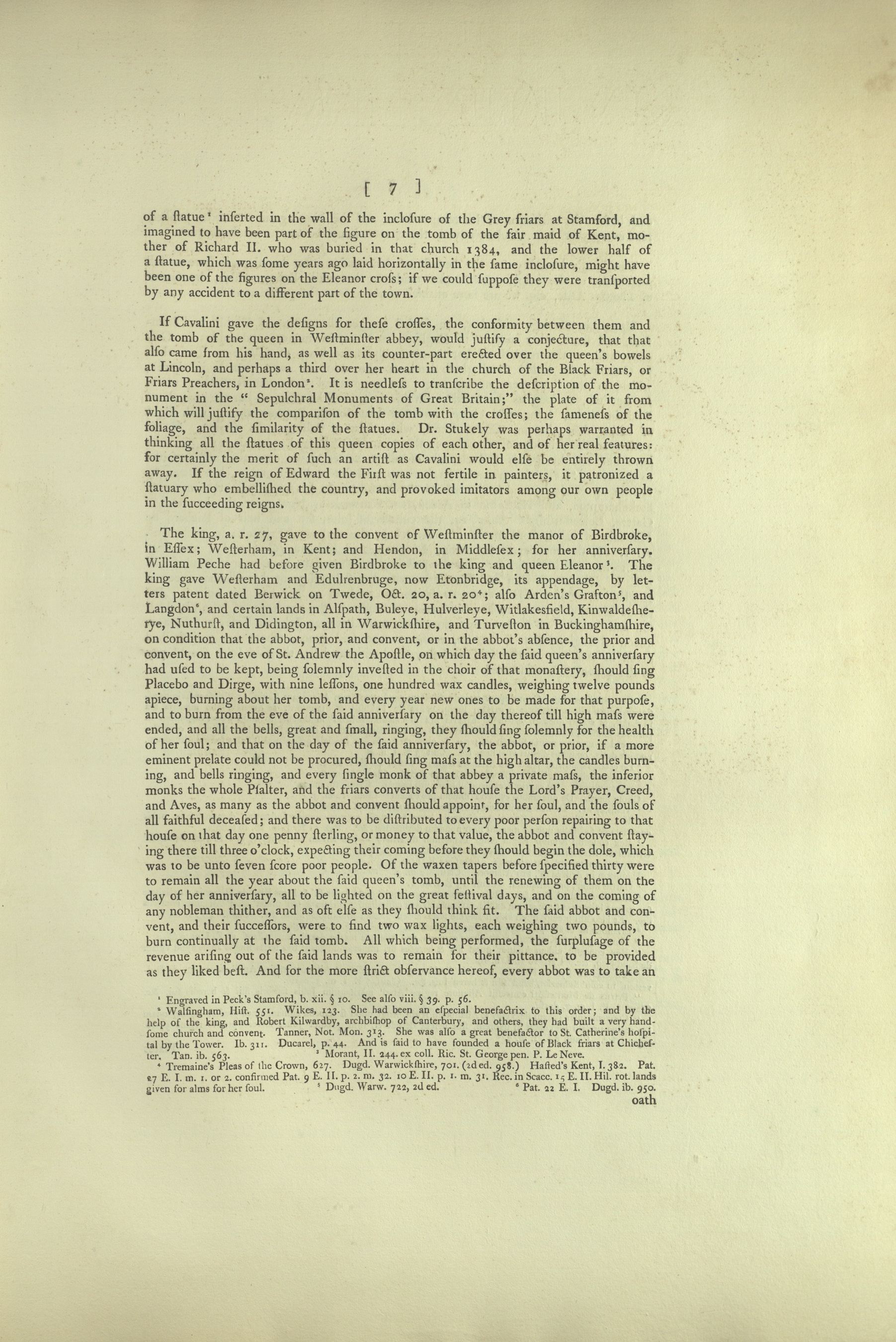
[ (Page) 7 ]
of a statue1 inserted in the wall of the inclosure of the Grey friars at Stamford, and imagined to have been part of the figure on the tomb of the fair maid of Kent, mother of Richard II. who was buried in that church 1384, and the lower half of a statue, which was some years ago laid horizontally in the same inclosure, might have been one of the figures on the Eleanor cross; if we could suppose they were transported by any accident to a different part of the town.
Read more/less…
If Cavalini gave the designs for these crosses, the conformity between them and the tom b of the queen in Westminster abbey, would justify a conjecture, that that also came from his hand, as well as its counter-part erected over the queen’s bowels at Lincoln, and perhaps a third over her heart in the church of the Black Friars, or Friars Preachers, in London2. It is needless to transcribe the description of the monument in the “Sepulchral Monuments of Great Britain;” the plate of it from which will justify the comparison of the tomb with the crosses; the sameness of the foliage, and the similarity of the statues. Dr. Stukeley was perhaps warranted in thinking all the statues of this queen copies of each other, and of her real features: for certainly the merit of such an artist as Cavalini would else be entirely thrown away. If the reign of Edward the First was not fertile in painters, it patronized a statuary who embellished the country, and provoked imitators among our own people in the succeeding reigns.
The king a. r. 27, gave to the convent of Westminster the manor of Birdbroke, in Essex; Westerham, in Kent; and Hendon, in Middlesex; for her anniversary. William Peche had before given Birdbroke to the king and queen Eleanor3. The king gave Westerham and Edulrenbruge, now Etonbridge, its appendage, by letters patent dated Berwick on Twede, Oct 20, a. r. 204; also Arden’s Grafton5, and Langdon6, and certain lands in Alspath, Buleye, Hulverleye, Witlakesfield, Kinwaldesherye, Nuthurst, and Didington, all in Warwickshire, and Turveston in Buckinghamshire, on condition that the abbot, prior, and convent, or in the abbot’s absence, the prior and convent, on the eve of St. Andrew the Apostle, on which day the said queen’s anniversary had used to be kept, being solemnly invested in the choir of that monastery, should sing Placebo and Dirge, with nine lessons, one hundred wax candles, weighing twelve pounds apiece, burning about her tomb, and every year new ones to be made for that purpose, and to burn from the eve of the said anniversary on the day thereof till high mass were ended, and all the bells, great and small, ringing, they should sing solemnly for the health of her soul; and that on the day of the said anniversary, the abbot, or prior, if a more eminent prelate could not be procured, should sing mass at the high altar, the candles burning, and bells ringing, and every single monk of that abbey a private mass, the inferior monks the whole Psalter, and the friars converts of that house the Lord’s Prayer, Creed, and Aves, as many as the abbot and convent should appoint, for her soul, and the souls of all faithful deceased; and there was to be distributed to every poor person repairing to that house on that day one penny sterling, or money to that value, the abbot and convent staying there till three o’clock, expecting their coming before they should begin the dole, which was to be unto seven score poor people. Of the waxen tapers before specified thirty were to remain all the year about the said queen’s tomb, until the renewing of them on the day of her anniversary, all to be lighted on the great festival days, and on the coming of any nobleman thither, and as oft else as they should think fit. The said abbot and convent, and their successors, were to find two wax lights, each weighing two pounds, to burn continually at the said tomb. All which being performed, the surplusage of the revenue arising out of the said lands was to remain for their [pittance to] be provided as they liked best. And for the more strict observance hereof, every abbot was to take an
1Engraved in Peck’s Stamford, b. xii. § 10. See also viii. § 39. p. 56.
2Walsingham, Hist. 551. Wikes, 123. She had been an especial benefactrix to this order; and by the help of the king, and Robert Kilwardby, archbishop of Canturbury, and others, they had built a very handsome church and convent. Tanner, Not. Mon. 313. She was also a great benefactor to St. Catherine’s hospital by the Tower. Ib. 311. Ducarel, p. 44. And is said to have founded a house of Black friars at Chichester. Tan. ib. 563.
3Morant, II. 244. ex coll. Ric. St. George pen. P. Le Neve.
4Tremaine’s Pleas of the Crown, 627. Dugd. Warwickshire, 701. (2d ed. 958) Hasted’s Kent, I. 382. Pat. 27 E. I. m. 1. or 2. confirmed Pat. 9 E. II. p. 2. m. 32. 10 E. II. p. 1. m. 31. Rec. in Scacc. 15 E. II. Hil. rot lands given for alms for her soul.
5Dugd. Warw. 722, 2d ed.
6Pat. 22 E. I. Dugd. ib. 950.
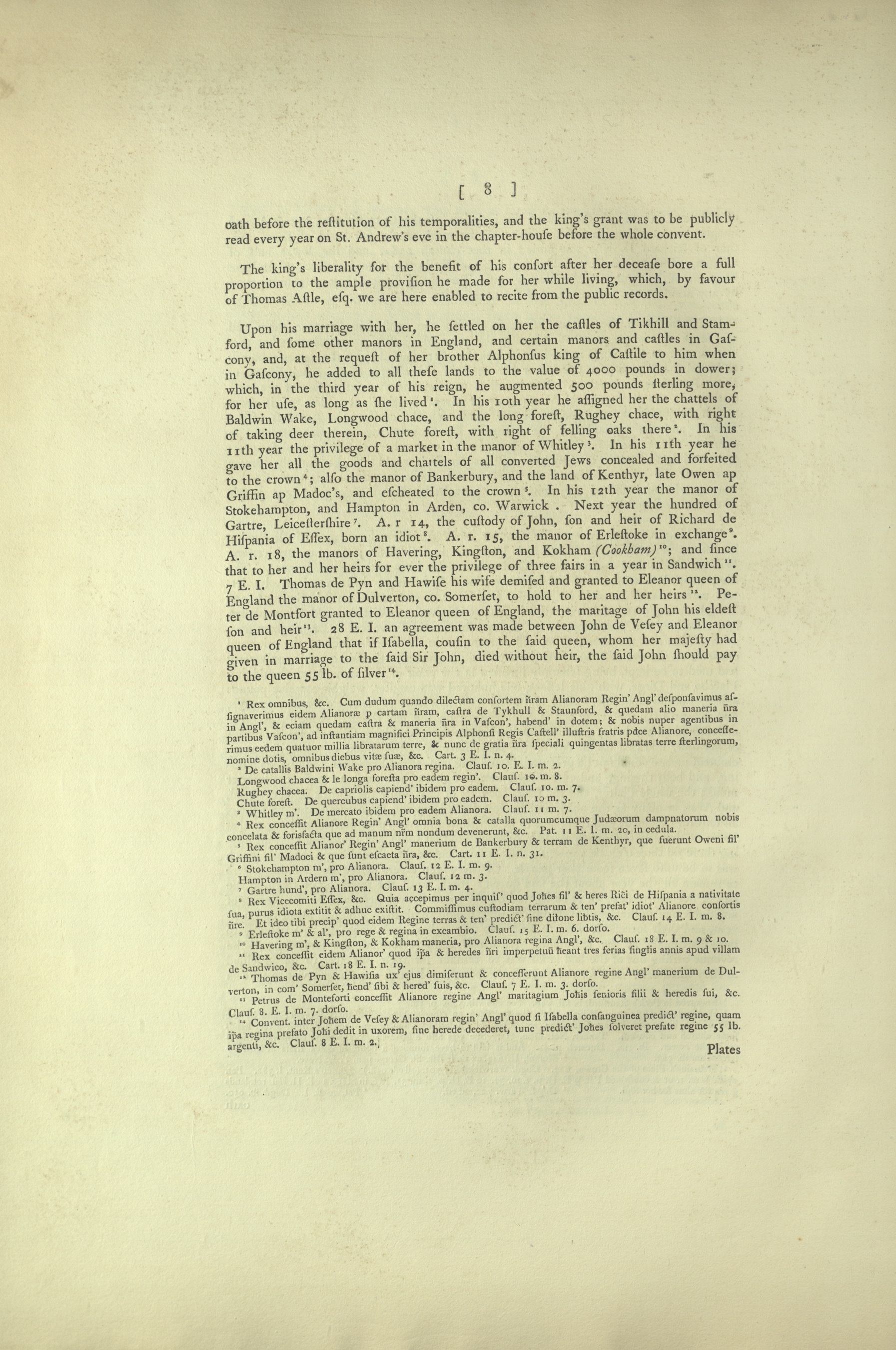
[ (Page) 8 ]
oath before the restitution of his temporalities, and the king’s grant was to be publicly read every year on St. Andrew’s eve in the chapter-house before the whole convent.
The king’s liberality for the benefit of his consort after her decease bore a full proportion to the ample provision he made for her while living, which, by favour of Thomas Astle, esq. we are here enabled to recite from the public records.
Read more/less…
Upon his marriage with her, he settled on her the castles of Tikhill and Stamford, and some other manors in England, and certain manors and castles in Gascony, and, at the request of her brother Alphonsus king of Castile to him when in Gascony, he added to all these lands to the value of 4000 pounds in dower; which, in the third year of his reign, he augmented to 500 pounds sterling more, for her use, as long as she lived1. In his 10th year he assigned her the chattels of Baldwin Wake, Longwood chace, and the long forest, Rughey chace, with right of taking deer therein, Chute forest, with right of felling oaks there2. In his 11th year the privilege of a market in the manor of Whitley3. In his 11th year he gave her all the goods and chattels of all converted Jews concealed and forfeited to the crown4; also the manor of Bankerbury, and the land of Kenthyr, late Owen ap Griffin ap Madoc’s, and escheated to the crown5. In his 12th year the manor of Stokehampton, and Hampton in Arden, co. Warwick. Next year the hundred of Gartre, Leicestershire7. A. r[.] 14, the custody of John, son and heir of Richard de Hispania of Essex, born an idiot8. A. r. 15, the manor of Erlestoke in exchange9. A. r. 18, the manors of Havering, Kingston, and Kokham (Cookham)10; and since that to her and her heirs for ever the privilege of three fairs in a year in Sandwich11. 7 E. I. Thomas de Pyn and Hawise his wife demised and granted to Eleanor queen of England the manor of Dulverton, co. Somerset, to hold to her and her heirs12. Peter de Montfort granted to Eleanor queen of England, the maritage of John his eldest son and heir13. 28 E. I. an agreement was made between John de Vesey and Eleanor queen of England that if Isabella, cousin to the said queen, whom her majesty had given in marriage to the said Sir John, died without heir, the said John should pay to the queen 55 lb. of silver14.
1Rex omnibus, &c. Cum dudum quando dilectam consortem ñram Alianoram Regin’ Angl’ desponsavimus assignaverimus eidem Alianoræ ᵽ cartam ñram, castra de Tykhull & Staunford, & quedam alio maneria ñra in Angl’, & eciam quedam castra & maneria ñra in Vascon’, habend’ in dotem; & nobis nuper agentibus in partibus Vascon’, ad instantiam magnifici Principis Alphonsi Regis Castell’ illustris fratris pđce Alianore, concesserimus eedem quatuor millia libratarum terre, & nunc de gratia ñra speciali quingentas libratas terre sterlingorum, nomine dotis, omnibus diebus vitæ suæ, &c. Cart. 3 E. I. n. 4. [see end of document for translation]
2De catallis Baldwini Wake pro Alianora regina. Claus 10 E. I. m. 2.
Longwood chacea & le longa foresta pro eadem regin’. Claus. 10. m. 8.
Rughey chacea De caprioles capiend’ ibidem pro eadem. Claus. 10. m. 7.
Chute forest. De quercubus capiend’ ibidem pro eadem. Claus. 10 m. 3.
3Whitley m’. De mercato ibidem pro eadem Alianora. Claus. 11 m. 7. [Whitley manor, with the privilege of a market therein for the same Eleanor.]
4Rex concessit Alianore Regin’ Angl’ omnia bona & catalla quorumcumque Judæorum dampnatorum nobis concelata & forisfacta que ad manum nr̃m. nondum devenerunt, &c. Pat. 11 E. I. m. 20, in cedula. [The king gave to Eleanor Queen of England all the goods and chattels of whatever condemned (“converted” in the gloss) Jews [there were], concealed and forfeited, which had not yet come into our possession, etc.]
5Rex concessit Alianor’ Regin’ Angl’ manerium de Bankerbury & terram de Kenthyr, que fuerunt Oweni fil’ Griffini fil’ Madoci & que sunt escaeta ñra, &c. Cart. 11 E. I, n. 31. [The king gave Eleanor Queen of England the manor of Bankerbury and the land of Kenthyr, which were Owen ap Griffin ap Madoc’s and which were escheated as ours, etc.]
6Stokehampton m’, pro Alianora. Claus. 12 E. I. m. 9. [The manor of Stokehampton for Eleanor]
Hampton in Ardern m’, pro Alianora. Claus. 12 m. 3. [The manor of Hampton in Arden for Eleanor] [Superscript no. 6 omitted from main text due to printer's error.]
7Gartre hund’, pro Alianora. Claus. 13 E. I. m. 4. [The hundred of Gartre for Eleanor]
8Rex Vicecomiti Essex, &c. Quia accepimus per inquis’ quod Joħes fil’ & hercs Rici. de Hispania a nativitate sua, purus idiota extitit & adhuc existit. Commissimus custodiam terrarum & ten’ prefat’ idiot’ Alianore consortis ñre. Et ideo tibi precip’ quod eidem Regine terras & ten’ predict’ sine diłone liƀtis, &c. Claus. 14 E. I. m. 8. [see end of document for translation]
9Erlestoke m’ & al’, pro rege & regina in excambio. Claus. 15 E. I. m. 6. dorso. [The manor of Elestok and others for the king and queen in exchange]
10Havering m’, & Kingston, & Kokham maneria, pro Alianora regina Angl’, &c. Claus. 18 E. I. m. 9 & 10. [The manors of Havering, Kingston, and Kokham, for Eleanor queen of England, etc.]
11Rex concessit eidem Alianor’ quod ip̃a. & heredes ñri imperptuū ħeant tres ferias singłis annis apud villam de Sandwico, &c. Cart. 18 E. I. n. 19. [The king granted to the same Eleanor that she herself and our heirs hold in perpetuity three fairs a year in the village of Sandwich, etc.]
12Thomas de Pyn & Hawisia ux’ ejus dimiserunt & concesserunt Alianore regine Angl’ manerium de Dulverton, in com’ Somerset, ħend’ sibi & hered’ suis, &c. Claus. 7 E. I. m. 3. dorso. [Thomas de Pyn and Hawife his wife demised and granted to Eleanor queen of England the manor of Dulverton in the county of Somerset to be held by her and her heirs, etc.]
13Petrus de Montesorti concessit Alianore regine Angl’ maritagium Joħis senioris filii & heredis sui, &c. Claus. 8. E. I. m. 7. dorso. [Peter de Montfort granted to Eleanor queen of England the maritage of John, his eldest son and heir.]
14Convent. Inter Joħem de Vesey & Alianoram regin’ Angl’ quod si Isabella consanguinea predict’ regine, quam ipa. Regina prefato Joħi dedit in uxorem, sine herede decederet, tunc predict’ Joħes solveret prefate regine 55 lb. argenti, &c. Claus. 8 E. I. m. 2. [see end of document for translation]
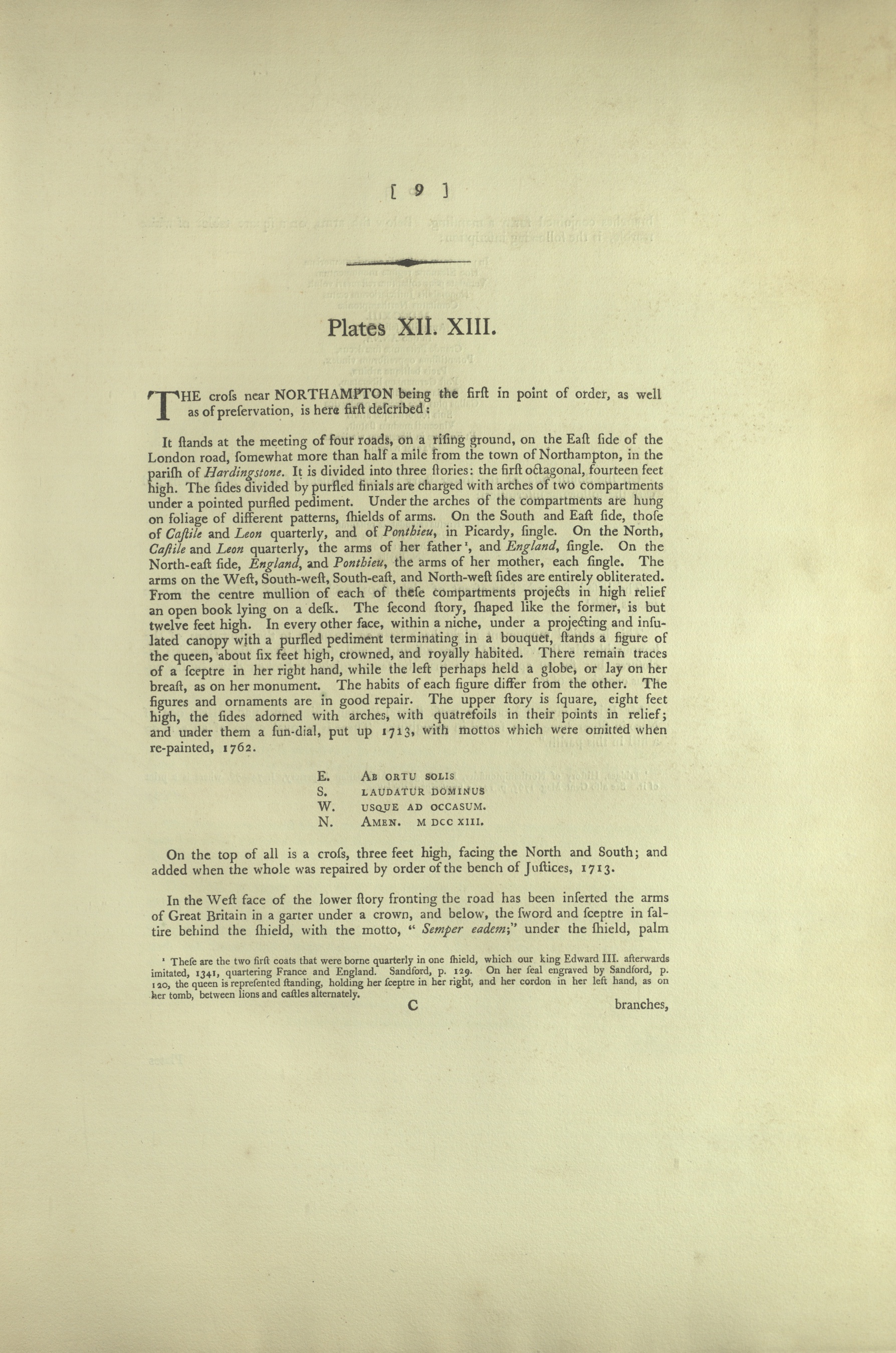
[ (Page) 9 ]
PLATES XII. XIII.
THE cross near NORTHAMPTON being the first in point of order, as well as of preservation, is here first described:
It stands at the meeting of four roads, on a rising ground, on the East side of the London road, somewhat more than half a mile from the town of Northampton, in the parish of Hardingstone. It is divided into three stories: the first octagonal, fourteen feet high.
Read more/less…The sides divided by purfled finials are charged with arches of two compartments under a pointed purfled pediment. Under the arches of the compartments are hung on foliage of different patterns, shields of arms. On the South and East side, those of Castile and Leon quarterly, and of Ponthieu, in Picardy, single. On the North, Castile and Leon quarterly, the arms of her father1, and England, single. On the North-east side, England, and Ponthieu, the arms of her mother, each single. The arms on the West, South-west, South-east, and North-west sides are entirely obliterated. From the centre mullion of each of these compartments projects in high relief an open book lying on a desk. The second story, shaped like the former, is but twelve feet high. In every other face, within a niche, under a projecting and insulated canopy with a purfled pediment terminating in a bouquet, stands a figure of the queen about six feet high, crowned, and royally habited. There remain traces of a scepter in her right hand, while the left perhaps held a globe, or lay on her breast, as on her monument. The habits of each figure differ from the other. The figures and ornaments are in good repair. The upper story is square, eight feet high, the sides adorned with arches, with quatrefoils in their points in relief; and under them a sun-dial, put up 1713, with mottos which were omitted when re-painted, 1762.
E. AB ORTU SOLIS
S. LAUDATUR DOMINUS
W. USQUE AD OCCASUM.
N. AMEN. M DCC XIII.
[E. from the rising of the sun
S. the Lord is praised
W. to its setting.
N. Amen. 1713.]
On the top of all is a cross, three feet high, facing the North and South; and added when the whole was repaired by order of the bench of Justices, 1713.
In the West face of the lower story fronting the road has been inserted the arms of Great Britain in a garter under a crown, and below, the sword and scepter in saltire behind the shield, with the motto, “Semper eadem;” [Always the same] under the shield, palm
1These are the two first coats that were borne quarterly in one shield, which our king Edward III. afterwards imitated, 1341, quartering France and England. Sandford, p. 129. On her seal engraved by Sandford, p. 120, the queen is represented standing, holding her sceptre in her right, and her cordon in her left hand, as on her tomb, between lions and castles alternately.
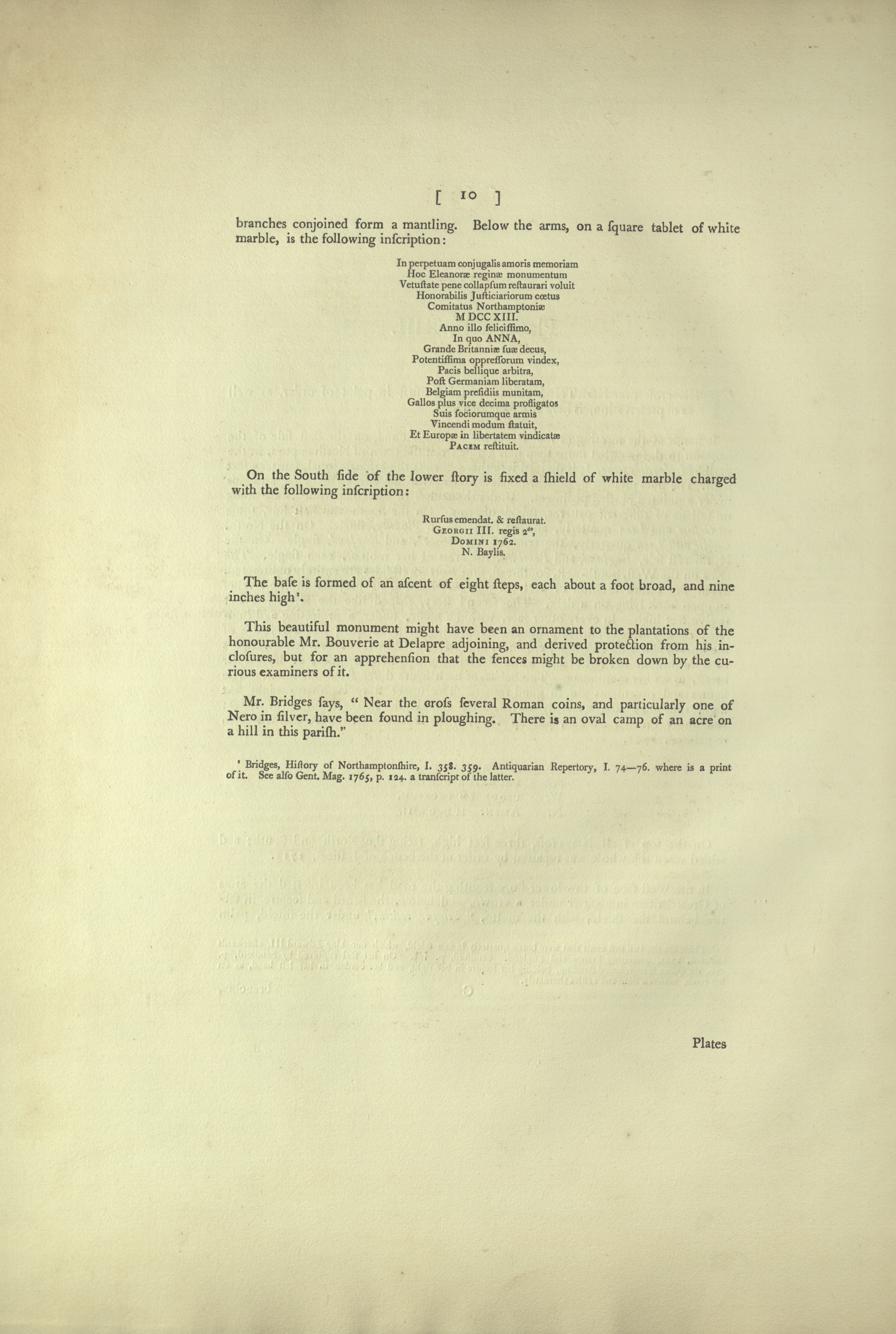
[ (Page) 10 ]
branches conjoined form a mantling. Below the arms, on a square tablet of white marble, is the following inscription:
In perpetuam conjugalis amoris memoriam
Hoc Eleanoræ reginæ monumentum
Vetustate pene collapsum restaurari voluit
Honorabilis Justiciariorum cœtus
Comitatus Northamptoniæ
M DCC XIII.
Read more/less…Anno illo felicissimo,
In quo ANNA,
Grande Britanniæ suæ decus,
Potentissima oppressorum vindex,
Pacis bellique arbitra,
Post Germaniam liberatam,
Belgiam presidiis munitam,
Gallos plus vice decima profligatos
Suis sociorumque armis
Vincendi modum statuit,
Et Europæ in libertatem vindicatæ
PACEM restituit.
[see end of document for translation]
On the South side of the lower story is fixed a shield of white marble charged with the following inscription:
Rursus emendat. & restaurat.
GEORGII III. regis 2do,
DOMINI 1762.
N. Baylis.
[Again cleaned and restored in the 2nd year of the reign of king George III in the year of our Lord 1762. N. Baylis.]
The base is formed of an ascent of eight steps, each about a foot broad, and nine inches high1.
This beautiful monument might have been an ornament to the plantations of the honourable Mr. Bouverie at Delapre adjoining, and derived protection from his inclosures, but for an apprehension that the fences might be broken down by the curious examiners of it.
Mr. Bridge says, “Near the cross several Roman coins, and particularly one of Nero in silver, have been found in ploughing. There is an oval camp of an acre on a hill in this parish.”
1Bridges, History of Northamptonshire, I. 358. 359. Antiquarian Reertory, I. 74—76. where is a print of it. See also Gent. Mag. 1765, p. 124. a transcript of the letter.
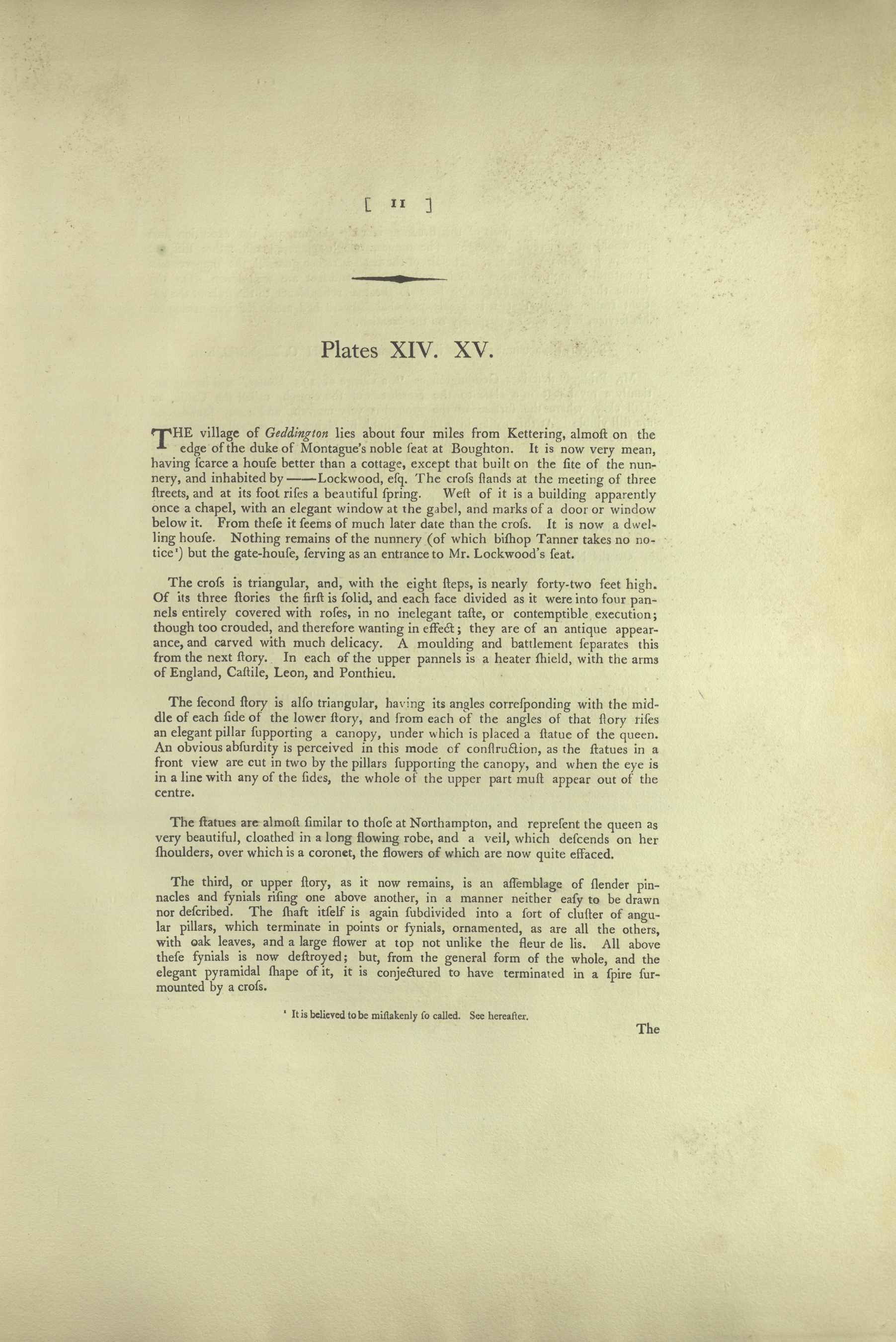
[ (Page) 11 ]
PLATES XIV. XV.
THE village of Geddington lies about four miles from Kettering, almost on the edge of the duke of Montague’s noble seat at Boughton. It is now very mean, having scarce a house better than a cottage, except that built on the site of the nunnery, and inhabited by —— Lockwood, esq. The cross stands at the meeting of three streets, and at its foot rises a beautiful spring.
Read more/less…West of it is a building apparently once a chapel, with an elegant window at the gabel, and marks of a door or window below it. From these it seems of much later date than the cross. It is now a dwelling house. Nothing remains of the nunnery (of which bishop Tanner takes no notice1) but the gate-house, serving as an entrance to Mr. Lockwood’s seat.
The cross is triangular, and, with the eight steps, is nearly forty-two feet high. Of its three stories the first is solid, and each face divided as it were into four pannels entirely covered with roses, in no inelegant taste, or contemptible execution; though too crouded, and therefore wanting in effect; they are of an antique appearance, and carved with much delicacy. A moulding and battlement separates this from the next story. In each of the upper pannels is a heater shield, with the arms of England, Castile, Leon, and Ponthieu.
The second story is also triangular, having its angles corresponding with the middle of each side of the lower story, and from each of the angles of that story rises an elegant pillar supporting a canopy, under which is placed a statue of the queen. An obvious absurdity is perceived in this mode of construction, as the statues in a front view are cut in two by the pillars supporting the canopy, and when the eye is in a line with any of the sides, the whole of the upper part must appear out of the centre.
The statues are almost similar to those at Northampton, and represent the queen as very beautiful, cloathed in a long flowing robe, and a veil, which descends on her shoulders, over which is a coronet, the flowers of which are now quite effaced.
The third, or upper story, as it now remains, is an assemblage of slender pinnacles and fynials rising one above another, in a manner neither easy to be drawn nor described. The shaft itself is again subdivided into a sort of cluster of angular pillars, which terminate in points or fynials, ornamented, as are all the others, with oak leaves, and a large flower at top not unlike the fleur de lis. All above these fynials is now destroyed: but, from the general form of the whole, and the elegant pyramidal shape of it, it is conjectured to have terminated in a spire surmounted by a cross.
1It is believed to be mistakenly so called. See hereafter.
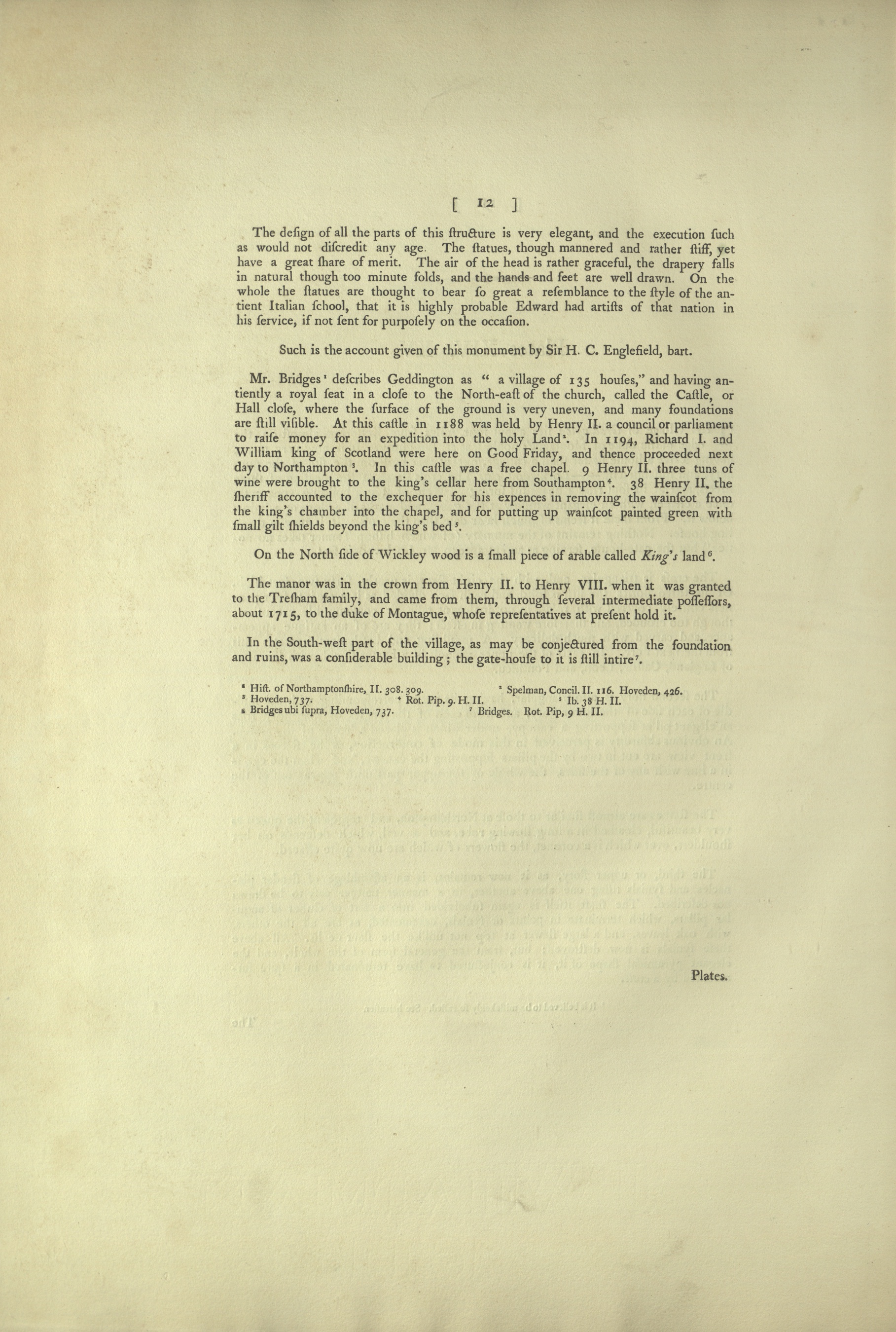
[ (Page) 12 ]
The design of all the parts of this structure is very elegant, and the execution such as would not discredit any age. The statues, though mannered and rather stiff, yet have a great share of merit. The air of the head is rather graceful, the drapery falls in natural though too minute folds, and the hands and feet are well drawn. On the whole the statues are thought to bear so great a resemblance to the style of the antient Italian school, that it is highly probably Edward had artists of that nation in his service, if not sent for purposely on the occasion.
Read more/less…
Such is the account given of this monument by Sir H. C. Englefield, bart.
Mr. Bridges1 describes Geddington as “a village of 135 houses,” and having antiently a royal seat in a close to the North-east of the church, called the Castle, or Hall close, where the surface of the ground is very uneven, and many foundations are still visible. At this castle in 1188 was held by Henry II. a council or parliament to raise money for an expedition into the holy Land2. In 1194, Richard I. and William king of Scotland were here on Good Friday, and thence proceeded next day to Northmapton3. In this castle was a free chapel. 9 Henry II. three tuns of wine were brought to the king’s cellar here from Southampton4. 38 Henry II. the sheriff accounted to the exchequer for his expences in removing the wainscot from the king’s chamber into the chapel, and for putting up wainscot painted green with small gilt shields beyond the king’s bed5.
On the North side of Wickley wood is a small piece of arable called King’s land6.
The manor was in the crown from Henry II. to Henry VIII. when it was granted to the Tresham family, and came from them, through several intermediate possessors, about 1715, to the duke of Montague, whose representatives at present hold it.
In the South-west part of the village, as may be conjectured from the foundation and ruins, was a considerable building; the gate-house to it is still intire7.
1Hist. of Northamptonshire, II. 308. 309.
2Spelman, Concil. II. 116. Hoveden, 426.
3Hoveden, 737.
4Rot. Pip. 9. H. II.
5Ib. 38 H. II.
6Bridges ubi supra [translation to be completed], Hoveden, 737.
7Bridges. Rot. Pip, 9 H. II.
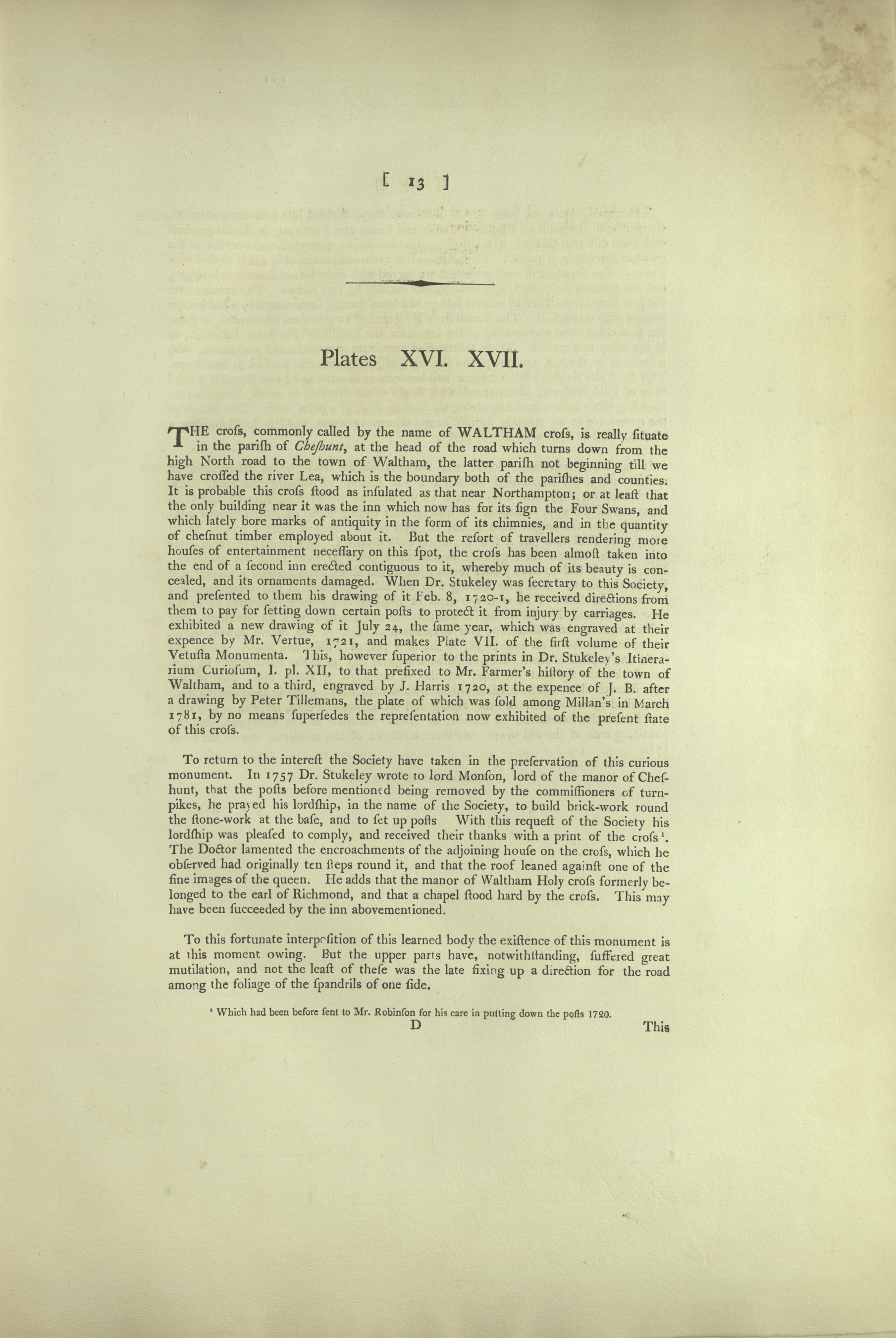
[ (Page) 13 ]
PLATES XVI. XVII.
THE cross, commonly called by the name of WALTHAM cross, is really situate in the parish of Cheshunt, at the head of the road which turns down from the high North road to the town of Waltham, the latter parish not beginning till we have crossed the river Lea, which is the boundary both of the parishes and counties. It is probable this cross stood as insulated as that near Northampton; or at least that the only building near it was the inn which now has for its sign the Four Swans, and which lately bore marks of antiquity in the form of its chimnies, and in the quantity of chesnut timber employed about it.
Read more/less…But the resort of travelers rendering more houses of entertainment necessary on this spot, the cross has been almost taken into the end of a second inn erected contiguous to it, whereby much of its beauty is concealed, and its ornaments damaged. When Dr. Stukeley was secretary to this Society, and presented to them his drawing of it Feb 8, 1720-1, he received directions from them to pay for setting down certain posts to protect it from injury by carriages. He exhibited a new drawing of it July 24, the same year, which was engraved at their expence by Mr. Vertue, 1721, and makes Plate VII. of the first volume of their Vetusta Monumenta. This, however superior to the prints in Dr. Stukeley’s Itinerarium Curiosum, I. pl. XII, to that prefixed to Mr. Farmer’s history of the town of Waltham, and to a third, engraved by J. Harris 1720, at the expence of J. B. after a drawing by Peter Tillemans, the plate of which was sold among Millan’s in March 1781, by no means supersedes the representation now exhibited of the present state of this cross.
To return to the interest the Society have taken in the preservation of this curious monument. In 1757 Dr. Stukeley wrote to lord Monson, lord of the manor of Cheshunt, that the posts before mentioned being removed by the commissioners of turnpikes, he prayed his lordship, in the name of the Society, to build brick-work round the stone-work at the base, and to set up posts[.] With this request of the Society his lordship was pleased to comply, and received their thanks with a print of the cross1. The Doctor lamented the encroachments of the adjoining house on the cross, which he observed had originally ten steps round it, and that the roof leaned against one of the fine images of the queen. He adds that the manor of Waltham Holy cross formerly belonged to the earl of Richmond, and that a chapel stood hard by the cross. This may have been succeeded by the inn abovementioned.
To this fortunate interposition of this learned body the existence of this monument is at this moment owing. But the upper parts have, notwithstanding, suffered great mutilation, and not the least of these was the late fixing up a direction for the road among the foliage of the spandrils of one side.
1Which had been before sent to Mr. Robinson for his care in putting down the posts 1720.
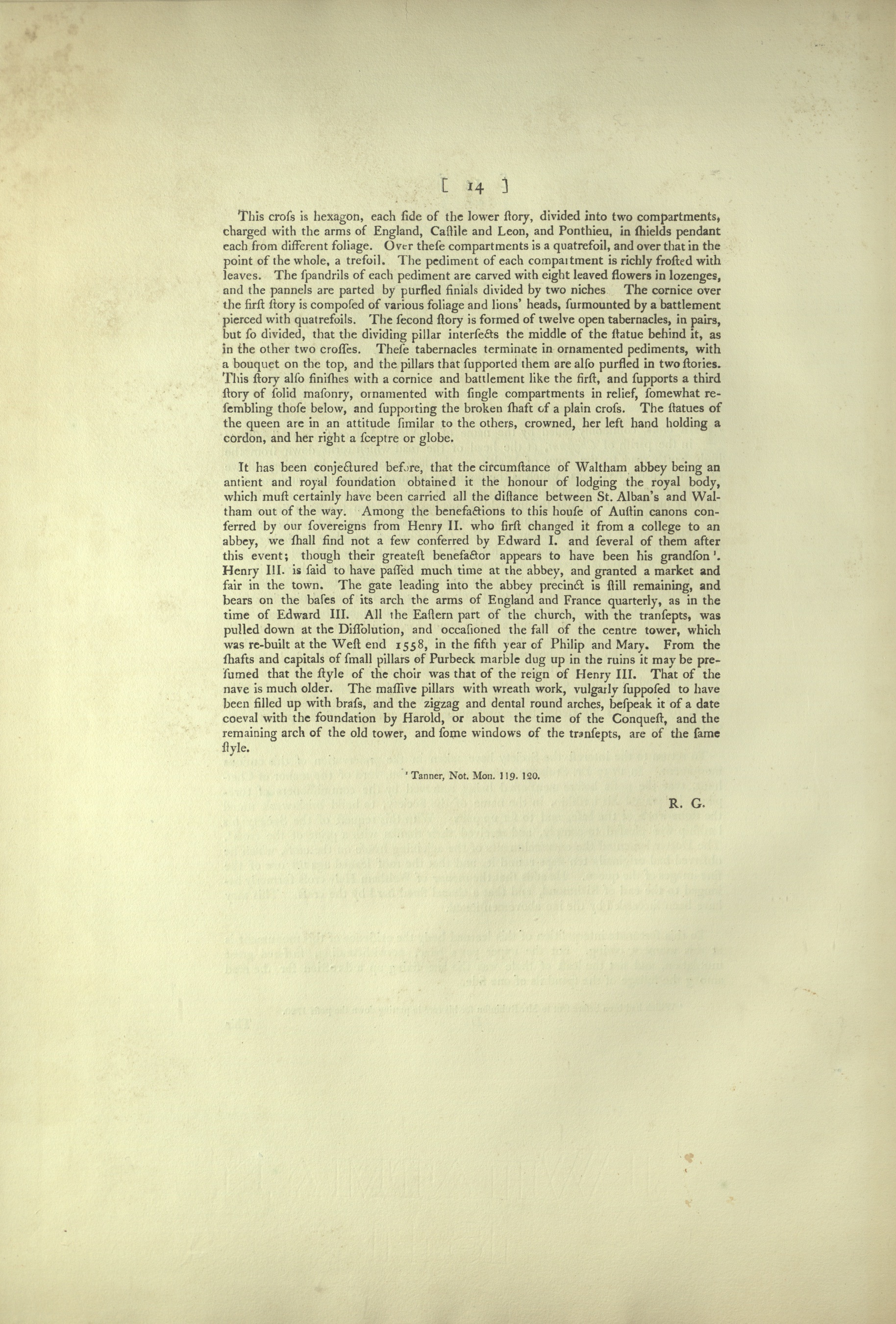
[ (Page) 14 ]
This cross is hexagon, each side of the lower story, divided into two compartments, charged with the arms of England, Castile and Leon, and Ponthieu, in shields pendant each from different foliage. Over these compartments is a quatrefoil, and over that in the point of the whole, a trefoil. The pediment of each compartment is richly frosted with leaves. The spandrils of each pediment are carved with eight leaved flowers in lozenges, and the pannels are parted by purfled finials divided by two niches[.]
Read more/less…The cornice over the first story is composed of various foliage and lions’ heads, surmounted by a battlement pierced with quatrefoils. The second story is formed of twelve open tabernacles, in pairs, but so divided, that the dividing pillar intersects the middle of the statue behind it, as in the other two crosses. These tabernacles terminate in ornamented pediments, with a bouquet on the top, and the pillars that supported them are also purfled in two stories. This story also finishes with a cornice and battlement like the first, and supports a third story of solid masonry, ornamented with single compartments in relief, somewhat resembling those below, and supporting the broken shaft of a plain cross. The statues of the queen are in an attitude similar to the others, crowned, her left hand holding a cordon, and her right a sceptre or globe.
It has been conjectured before, that the circumstance of Waltham abbey being an antient and royal foundation obtained it the honour of lodging the royal body, which must certainly have been carried all the distance between St. Alban’s and Waltham out of the way. Among the benefactions to this house of Austin canons conferred by our sovereigns from Henry II. who first changed it from a college to an abbey, we shall find not a few conferred by Edward I. and several of them after this event; though their greatest benefactor appears to have been his grandson1. Henry III. is said to have passed much time at the abbey, and granted a market and fair in the town. The gate leading into the abbey precinct is still remaining, and bears on the bases of its arch the arms of England and France quarterly, as in the time of Edward III. All the Eastern part of the church, with the transepts, was pulled down at the Dissolution, and occasioned the fall of the centre tower, which was re-built at the West end 1558, in the fifth year of Philip and Mary. From the shafts and capitals of small pillars of Purbeck marble dug up in the ruins it may be presumed that the style of the choir was that of the reign of Henry III. That of the nave is much older. The massive pillars with wreath work, vulgarly supposed to have been filled up with brass, and the zigzag and dental round arches, bespeak it of a date coeval with the foundation by Harold, or about the time of the Conquest, and the remaining arch of the old tower, and some windows of the transepts, are of the same style.
1Tanner, Not. Mon. 119. 120.
R.[ichard] G.[ough]
Translations of the Longer Passages:
Page 1, lines 2-5: In every place and vill in which the body stopped, the king ordered a cross with a plaque be erected in memory of the queen that passers-by might pray for her soul at the cross, on which he had the queen’s image painted.
Page 8, footnote 1: The king to all, etc. after we betrothed a short time ago our dear consort Eleanor Queen of England and by our charter conferred to the same Eleanor the castles of Tikhill and Stamford and some other manors of ours elsewhere in England and even some castles and manors of ours in Gascony to be held as dowry, and while we were recently conducting business in parts of Gascony at the instance of the magnificent Prince Alphonse King of Castile, the illustrious brother of the foresaid Eleanor, we granted to the same four thousand pounds of land and now by our special grace five hundred pounds sterling of land, as a dowry, for all the days of her life, etc.
Page 8, footnote 8: The king to the Vicount of Essex, etc. because we have regarded it as most unjust that John, the son and heir of Richard de Hispania from birth, has been and still is a complete idiot. We gave the wardenship of the lands and tenements of the aforesaid idiot to our consort Eleanor. And thus I instruct you to release to the same Queen the lands and the foresaid tenements without delay, etc.
Page 8, footnote 14: An agreement was made between John de Vesey and Eleanor queen of England that if Isabella, cousin to the aforesaid queen, whom the Queen herself gave in marriage to the aforesaid John, died without heir, then the aforesaid John should pay the aforesaid queen 55 lb. of silver, etc.
Page 10, lines 3-20: An honorable gathering of justices in the county of Northampton wished that this monument of queen Eleanor in lasting recognition of her conjugal love, having almost collapsed with the passage of time, be restored [in] 1713. In that most happy year, in which Anna, a great glory to her Britain, most powerful vindicator of the oppressed, arbiter of peace and war, after the liberation of Germany, the fortification of Belgium, the conquest of the French for more than the tenth time, established a way to victory by force of arms, her own and allied, and re-established peace for Europe restored to freedom.














